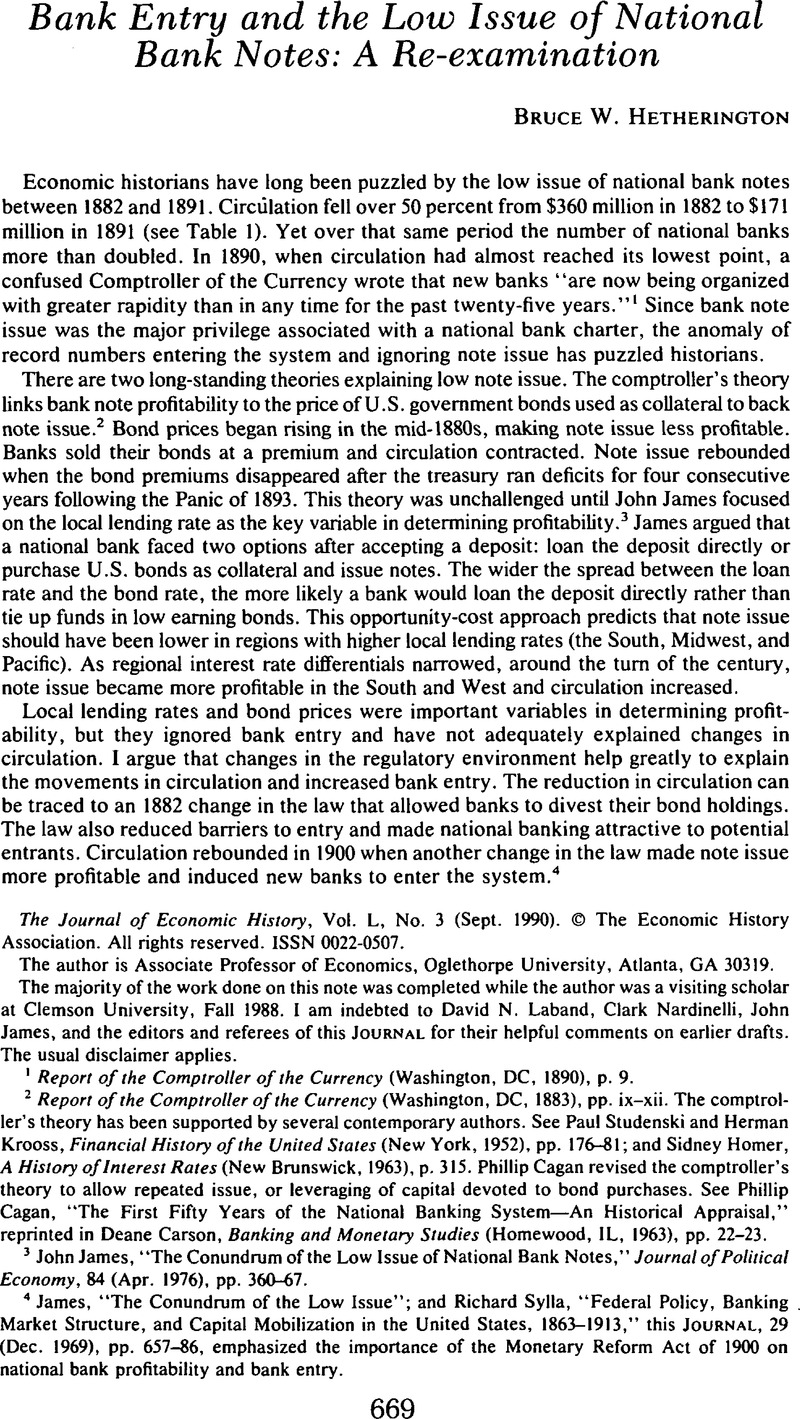Published online by Cambridge University Press: 03 March 2009

1 Report of the Comptroller of the Currency (Washington, DC, 1890), p. 9.Google Scholar
2 Report of the Comptroller of the Currency (Washington, DC, 1883), pp. ix–xii.Google Scholar The comptroller's theory has been supported by several contemporary authors. See Studenski, Paul and Krooss, Herman, Financial History of the United States (New York, 1952), pp. 176–81;Google Scholar and Homer, Sidney, A History of Interest Rates (New Brunswick, 1963), p. 315.Google Scholar Phillip Cagan revised the comptroller's theory to allow repeated issue, or leveraging of capital devoted to bond purchases. See Phillip Cagan, “The First Fifty Years of the National Banking System—An Historical Appraisal,” reprinted in Carson, Deane, Banking and Monetary Studies (Homewood, IL, 1963), pp. 22–23.Google Scholar
3 James, John, “The Conundrum of the Low Issue of National Bank Notes,” Journal of Political Economy, 84 (04 1976), pp. 360–67.CrossRefGoogle Scholar
4 James, “The Conundrum of the Low Issue” and Sylla, Richard, “Federal Policy, Banking Market Structure, and Capital Mobilization in the United States, 1863–1913,” this JOURNAL, 29 (12 1969), pp. 657–86, emphasized the importance of the Monetary Reform Act of 1900 on national bank profitability and bank entry.Google Scholar
5 Calomiris, Charles W., “Price and Exchange Rate Determination During the Greenback Suspension,” Oxford Economic Papers, 40 (12 1988), pp. 189–220.CrossRefGoogle Scholar
6 Calomiris, Charles W. and Hubbard, Glenn R., “Evaluating Theories of International Adjustment Under the Classical Gold Standard” (NBER Working Paper No. 2206, Apr. 1987).Google Scholar
7 In order to receive a national bank charter, minimum capital requirements had to be met: $50,000 in areas where population was less than 6,000 (nonreserve city banks) and $150,000 where population exceeded 6,000 (reserve city banks).Google Scholar
8 After setting aside a 5 percent redemption fund against notes outstanding (the bank would usually exchange 5 percent of its own notes for gold) the bank would loan the remaining national bank notes.Google Scholar
9 The Act of July 12, 1882, was especially favorable to reserve city banks, those with capital in excess of $200,000, for no matter how large such a bank was, after the act it only had to hold $50,000 in government bonds to secure circulation. Reserve city banks stood to make considerable windfalls by divesting their bond holdings.Google Scholar
10 New entry was especially rapid in areas where population was less than 3,000 inhabitants.Google Scholar
11 The $70 million increase in circulation between 1892 and 1899 was not the result of increased note profitability. Instead, banks increased circulation as a means to pay off depositors following the panics of 1893 and 1897. In the 1899 Annual Report the comptroller stated that national banks, in 1893, paid off $31.2 million in depositors by increasing circulation. An additional $11 million would have been issued to pay depositors, but the comptroller's office experienced a printing delay. Report of the Comptroller of the Currency (Washington, DC, 1899), p. xii.Google Scholar A similar incident occurred in 1897 and 1898 when state banks gave national banks U.S. bonds in exchange for national bank notes. State banks then paid off their depositors with national bank notes. For further detail of these two incidents, see Bradstreet's, Aug. 15, 1893Google Scholar; Financial Review (New York, 1901), pp. 61–63Google Scholar; and Hoffmann, Charles, The Depression of the Nineties—An Economic History (Westport, CT, 1970), p. 207.Google Scholar
12 Report of the Comptroller of the Currency (Washington, DC, 1891), p. 44.Google Scholar